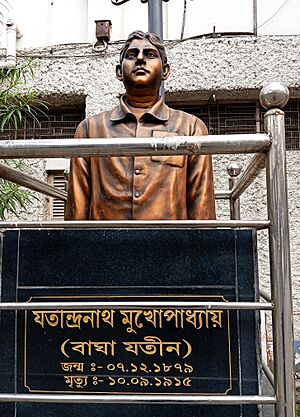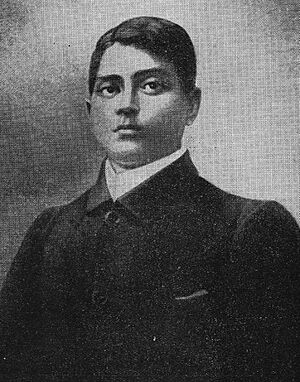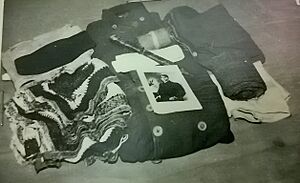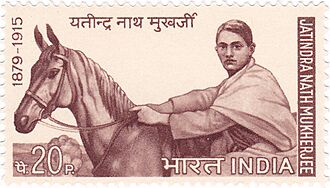Bagha Jatin facts for kids
Quick facts for kids
Bagha Jatin
|
|
|---|---|

Mukherjee in 1909
|
|
| Born | 7 December 1879 Kumarkhali, Bengal, British India
|
| Died | 10 September 1915 (aged 35) Balasore, Bihar and Orissa, British India
|
| Cause of death | Gunshot wound |
| Nationality | British Indian |
| Other names | Bagha Jatin |
| Education | University of Calcutta |
| Occupation | Indian independence activist |
| Organisation | Jugantar |
| Known for | Freedom Struggle |
| Movement | Indian Independence movement |
| Signature | |
Bagha Jatin (meaning "Tiger Jatin"), born Jatindranath Mukherjee, was an important Indian freedom fighter. He lived from December 7, 1879, to September 10, 1915. He was a key leader of the Jugantar party. This group worked to free India from British rule.
Contents
- Early Life of Bagha Jatin
- Student Days in Calcutta
- Family Life
- How Jatin Became "Bagha Jatin"
- Early Revolutionary Actions
- Organizing Secret Societies
- The Spirit of Bagha Jatin
- The Howrah-Sibpur Conspiracy Case
- A New Plan for Freedom
- During World War I
- The Last Battle and Jatin's Death
- Legacy of a Hero
- Images for kids
- See also
Early Life of Bagha Jatin
Jatin was born in a village called Kayagram in Bengal. This was on December 7, 1879. His father passed away when Jatin was only five years old. His mother, Sharatshashi, was a gifted poet. She raised Jatin and his elder sister, Benodebala.
Jatin was known for his bravery and strength from a young age. He enjoyed acting in plays about brave and good characters. He also encouraged others to create patriotic plays. These plays helped spread the idea of freedom in villages.
Student Days in Calcutta
After finishing school in 1895, Jatin went to Calcutta Central College. He studied Fine Arts there. He also learned stenotyping, a new skill for good jobs. Jatin was greatly inspired by Swami Vivekananda. Vivekananda believed India needed to be free to grow spiritually.
Swami Vivekananda gathered young volunteers. They helped people during famines and floods. They also ran clubs to help young men become strong and brave. Jatin joined these efforts. He was known for his strong will and dedication to the cause of freedom.
Family Life
In 1900, Jatin married Indubala Banerjee. They had four children together. Their first child, Atindra, sadly passed away young. After this loss, Jatin and his family went on a pilgrimage. They found peace and received blessings from a holy man. This holy man supported Jatin's fight for freedom.
How Jatin Became "Bagha Jatin"
In March 1906, Jatin returned to his village. He heard about a tiger causing trouble nearby. Jatin went into the jungle and fought the tiger with his bare hands. He used a small dagger to kill it.
Jatin was badly wounded, but he recovered. A famous surgeon helped him. The government even gave him a silver shield for his bravery. From then on, people called him 'Bagha', which means 'Tiger' in Bengali. So, he became known as Bagha Jatin.
Early Revolutionary Actions
Jatin was one of the founders of the Anushilan Samiti in 1902. This was a secret group working for India's freedom. He helped set up branches of this group in different areas. In 1903, Jatin met Sri Aurobindo. They decided to work together. Jatin wanted to convince Indian soldiers in the British army to join the fight for freedom.
In 1905, Jatin showed his bravery in Calcutta. He saw some English military men disrespecting Indian ladies. Jatin confronted them and made them leave the ladies alone. This act showed his courage and his stand against unfair treatment.
Organizing Secret Societies
Jatin helped set up a bomb factory near Deoghar. He also worked to create a network of small, independent groups. These groups were spread across Bengal and other regions. Jatin organized relief missions during floods and epidemics. He also helped with religious gatherings.
Police suspected he used these events to meet leaders and recruit new freedom fighters. In 1907, Jatin worked in Darjeeling. He continued to spread ideas of freedom. In 1908, he fought with English officers at Siliguri railway station. The case was widely reported. Jatin stated he would always defend himself and his countrymen's rights.
Jatin became the leader of the Jugantar Party. He connected all the different groups fighting for freedom. He even leased land in the Sundarbans to hide revolutionaries. He also helped students go abroad to study and learn military skills.
The Spirit of Bagha Jatin
After some major arrests, Jatin organized daring actions. These acts helped people believe in the freedom movement again. He introduced a new way of getting funds: bank robberies using taxi-cabs. These were called "Taxicab dacoities."
Several attacks were carried out. Two police officers who were trying to get revolutionaries convicted were assassinated. One of the assassins, Biren Datta Gupta, named Jatin as his leader.
The Howrah-Sibpur Conspiracy Case
In January 1910, Jatin was arrested. He was accused of planning to wage war against the British King. He was also accused of trying to turn Indian soldiers against the British. This case was known as the Howrah-Sibpur conspiracy case.
While in jail, Jatin learned that Germany might declare war on England. He hoped this war would help India gain freedom. He planned an armed uprising with Indian soldiers. However, the case against Jatin failed due to lack of evidence. He was released in February 1911.
A New Plan for Freedom
After his release, Jatin stopped armed actions for a while. He lost his government job and was kept under watch. But he found a way to leave Calcutta. He started a business building a railway line. This allowed him to travel and connect with freedom fighters across India.
Jatin also went on another pilgrimage. He met Swami Niralamba, who had been a revolutionary himself. Niralamba gave Jatin more contacts in North India. Jatin then reorganized the Jugantar party. During a flood in 1913, Jatin's relief work brought many leaders together. Everyone saw him as their leader.
Jatin also met Rasbehari Bose, another important revolutionary. They discussed a large uprising, similar to the 1857 revolt. Bose was impressed by Jatin's energy. He started talking to Indian soldiers in Calcutta's Fort William.
Indian revolutionaries living abroad also joined the effort. Taraknath Das organized schools for Indian immigrants in the United States. They learned about their rights and their duty to India. They published newspapers like Free Hindustan. Har Dayal also joined the movement. He founded the journal Ghadar (Revolt) and the Yugantar Ashram.
During World War I
When World War I began in 1914, a group called the Berlin Committee was formed. It included Indian revolutionaries living abroad. They got support from the German government. Germany promised to send arms and money to help an uprising in India.
This plan was directly linked to Jatin's Jugantar party. It became known as the German Plot or the Hindu–German Conspiracy. Jugantar started raising money through armed robberies. Jatin also tried to contact Sikh soldiers in a gunpowder magazine.
Police activities increased, so Jatin moved to a safer place. He went to a hideout in Mayurbhanj, near Balasore. A business called "Universal Emporium" was set up to help him communicate with revolutionaries abroad.
In April 1915, Jatin's associate, Naren Bhattacharya, went to Batavia. He met with German officials. They confirmed that a shipment of arms was on its way to help the Indian revolution.
However, a network of Czech and Slovak spies in the United States discovered Jatin's plans. They passed the information to the British and Americans.
The Last Battle and Jatin's Death
Jatin was warned about the British action. He was asked to leave his hiding place. But he waited for his friends, Niren Dasgupta and Jyotish Pal. This delay allowed a large police and army force to surround them.
Jatin and his companions walked through forests for two days. On September 9, 1915, they took cover on a hillock in Balasore. Jatin refused to leave his friends. A gunfight began, lasting 75 minutes. The five revolutionaries, armed with pistols, fought against many police and soldiers with modern rifles.
This incident is known as the Battle of Balasore. Chittapriya Ray Chaudhuri died on the spot. Jatin and Jyotish Pal were seriously wounded. Manoranjan Sengupta and Niren were captured when their ammunition ran out. Jatindranath Mukherjee died at the Balasore district hospital on September 10, 1915.
Legacy of a Hero
Jatin's famous words were: "We will die, the world will awaken." Charles Tegart, the British Intelligence Chief, admired him greatly. He said, "Though I had to do my duty, I have a great admiration for him. He died in an open fight." Tegart later admitted that if the Indian army had risen, the British would have lost the war.
Mahatma Gandhi called Jatin "a divine personality." Tegart even said that if Jatin were English, his statue would be next to Nelson's in Trafalgar Square. He described Bengali revolutionaries as "the most selfless political workers in India."
Today, a place in Kolkata is named Baghajatin after him. There is also a statue of Bagha Jatin in Balasore, where he fought his last battle.
Images for kids
-
Jatin in 1895, shortly before joining the University of Calcutta
-
Jatin at the age of 24, in Darjeeling, 1903
-
Statue of Bagha Jatin near Victoria Memorial, Kolkata
See also
- Bagha Jatin (2023 film)











